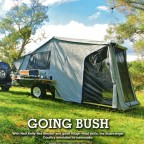- Home
- About Us
- Quest RV
- Pioneer
- Bushranger
- Camper Hire
- Campers 4 Sale
- Road Tests
- Accessories
- Finance
- Location
- Contact
Towing Tips
Towing Your Trailer Safely
Perform a safety inspection before each trip.
Make sure that:
- the pin securing the ball mount to the receiver is intact.
- the hitch coupler is secured.
- spring bar hinges are tight with the safety clips in place (load equalizer or weight distributing hitches).
- safety chains are properly attached.
- the electrical plug is properly installed.
People who tow trailers share the same safety concerns as other RV owners. However, a tow vehicle and a trailer form an articulated (hinged) vehicle which presents an additional set of concerns. The weight considerations (described in section Weighing a Trailer) are very important to safe towing. The tow vehicle must be a proper match for the trailer. If the trailer is properly equipped, it can perform safely under a variety of driving conditions. The tow vehicle should also have enough performance to climb mountain grades without excessive loss of speed.
Balance – Before you tow a trailer, evaluate trailer weight distribution. Hitch weights for travel trailers should typically be at least 10 percent of gross weight of the trailer for acceptable handling. In some cases it can go to 15 percent or higher. Hitch weight for larger trailers is limited by the capacities of tow vehicles and hitches. The strongest load-distributing hitch is rated for a maximum hitch weight of 1200 pounds. Most passenger car suspensions cannot handle that much weight and the trailer should be towed with a pickup truck or van. Improper weight distribution can cause the trailer to fishtail (sway back and forth across the lane).
Sway Control – You should have good trailer handling if the weight and hitch adjust ments are correct. However, the coupling between a tow vehicle and trailer should also prevent side to side motion for best possible towing comfort and safety. If you detect sway in your trailer, stop and check to see if the load has shifted. Check for suspension problems and make sure the tires and wheels are secure and inflated properly. Be sure the trailer hitch is secure. A small reduction in tire air pressure or a slight increase in tongue weight may help. A sway control device should be included when the hitch is installed. This device helps give the tow vehicle and trailer a one-vehicle feel. There are two basic types of sway control systems available:
Friction bar – slides in and out and is activated by the motion of the vehicles. When you brake or turn, the trailer weight compresses the bar which then compresses the trailer against the tow vehicle.
Dual cam sway control – usually works better for large trailers with heavy tongue weights. The cam action is applied to the spring of the trailer to reduce sway and shifts the weight forward. It also adjusts weight shifts which allows the trailer to follow the tow vehicle.







